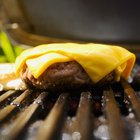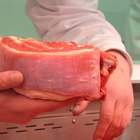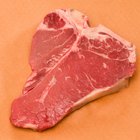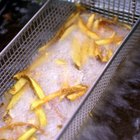Smokiness has its time and place when cooking a burger, namely a backyard barbecue, but certainly not in a cramped kitchen with poor ventilation. Burgers create smoke for a host of reasons, but primarily because of an oversized pan, using an oil with a low-smoking point, cooking on a burner too large for the frying pan and frying with excessive heat. A few simple modifications in cooking method, along with choosing the right tools for the job, ensures you get a golden-brown sear and fry your burgers to a safe temperature, without the smoke that commonly accompanies it.
Portion 20-percent fat, or 80/20, ground beef to between 6 and 8 ounces. Hamburger with 80-percent leanness has just enough fat to keep the burgers moist during cooking, one of the most important steps in preventing smoke.
Form the patties to about 4 1/2 inches wide and 3/4- to 1-inch thick. Six- to 8-ounce, 3/4- to 1-inch patties are just thick enough to cook for several minutes at low heat without drying. Pack the burgers firmly and roll them tightly before flattening them to prevent any stray pieces of meat separating and burning up in the pan.
Select a nonstick pan just large enough to accommodate the burger or burgers while allowing about 1/2 inch of space on all sides. You want a nonstick pan because you're cooking with low heat, and stainless-steel and cast-iron requires high heat to achieve nonstick properties. You need a pan just large enough to contain the burgers because the juices and fats that render out burn when they come in contact with the empty parts of the pan, which have a higher surface temperature than the portion of the pan on which the hamburger sits.
Coat the pan with a thin patina of high-heat oil. Although you're using a nonstick pan, a small amount of high-heat oil facilitates the rendering process. Canola, peanut and sunflower oil all have smoke points higher than the temperature at which you cook the hamburgers.
Set the pan on the stove on a burner that closely matches the pan size. If you place a small pan on a large burner, the dry sides of the pan get hot and cause the fat to smoke when it splatters on them. If you use a burner too small for the pan, the pan heats unevenly and doesn't cook the burger uniformly.
Set the stove's burner to medium-low. Medium-low on a stove corresponds with a temperature range of 250 to 324 degrees Fahrenheit. It might seem low, but it's right at the 250 F needed to create a Maillard reaction -- the chemical reaction that gives burgers a golden-brown color and complex aroma -- yet far below the smoking point of beef fat, 401 F, and the point of fat pyrolysis, or carbonizing, which occurs at 355 F. Let the pan heat for about five minutes.
Place the hamburger patties in the pan, allowing 1/2 inch of space on all sides. Cover the pan with a lid. Covering the pan serves several purposes. It holds in steam, which gently cooks the burgers, and it prevents splattering outside the pan. Most importantly, though, condensation forms on the underside of the lid and drops back down into the pan, keeping it moist and smoke free.
Cook the hamburgers for about six minutes and turn them over using a spatula. Only turn the burgers once during cooking. Replace the lid.
Cook the burgers for three minutes after turning and remove the lid. Cook for three minutes with the lid off and check the internal temperature. Remove the pan from the stove and lift the hamburger from it with a spatula to check the temperature. If you insert the thermometer with the burger in the pan, you won't get an accurate reading.
Insert a meat thermometer in the side of the burger horizontally. The U.S. Department of Agriculture recommends cooking ground beef to a minimum internal temperature of 160 F. If the burger has reached 160 F, it's ready to serve. If not, return it to the pan, cover and cook an additional one minute for every five degrees it measured below 160 F.
Related Articles

How to Cook the Perfect Burger Indoors ...

How to Make a Moist Hamburger

How to Cook Lean Hamburgers

How to Cook a Frozen Burger in a Skillet

How to Cook With Stainless-Steel Frying ...

How to Keep Hamburgers From Puffing Up ...

How to Cook Bison Burger

How to Cook Deer Sirloin
How to Make Waffles Without an Iron

How to Cook Rib Eye Steak in an ...

How to Cook Brisket on a Propane Grill
How to Hold Hamburgers in a Steam Tray

Tips for Cooking Hamburgers on a Grill

How to Smoke Hamburgers

How to Make Sure Your Hamburger Is ...

How to Barbecue Roast Beef

How to Broil Strip Steak

Alternatives to a Deep Fryer

How to Grill Hamburgers in the Oven
Do You Drain the Marinade Before ...
References
Writer Bio
A.J. Andrews' work has appeared in Food and Wine, Fricote and "BBC Good Food." He lives in Europe where he bakes with wild yeast, milks goats for cheese and prepares for the Court of Master Sommeliers level II exam. Andrews received formal training at Le Cordon Bleu.